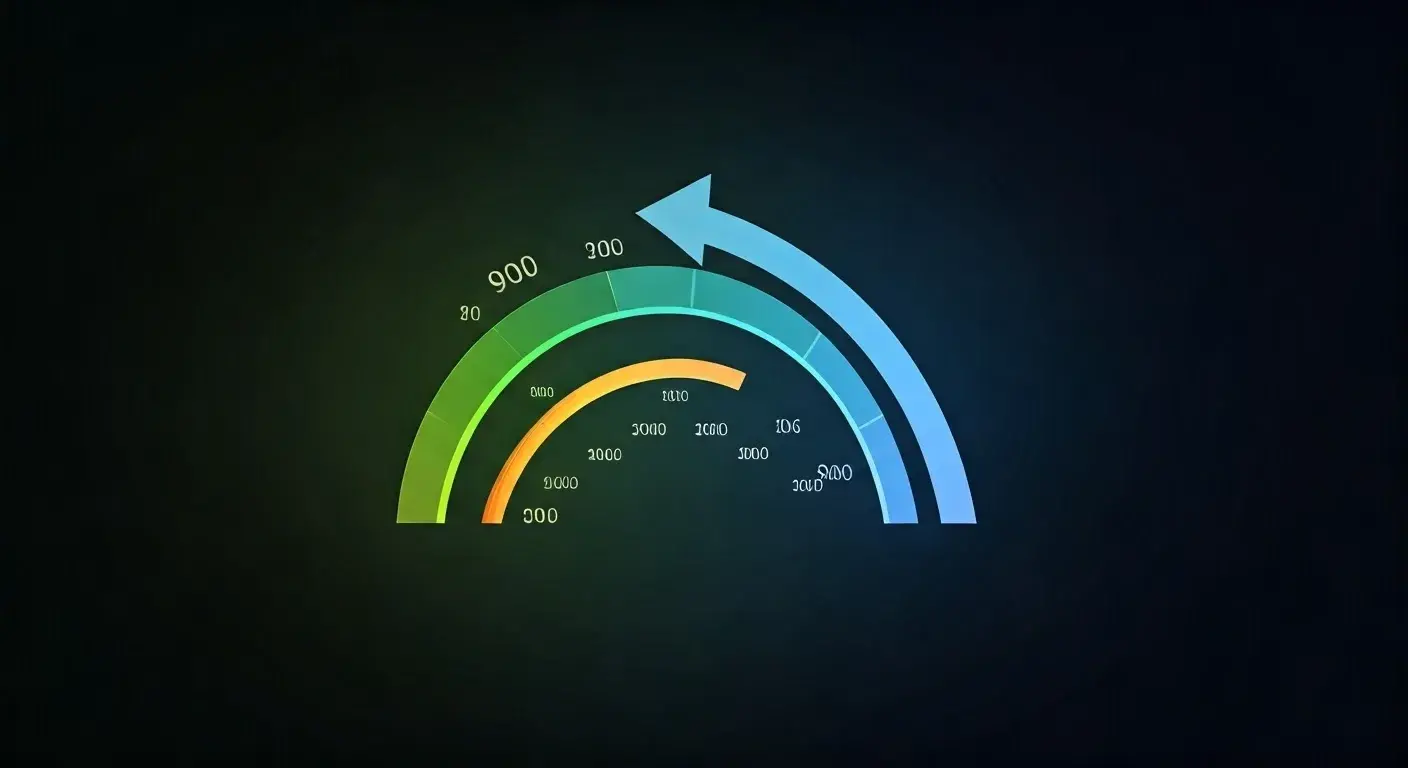-
Posted on: 20 Jan 2023

-
Unlock financial freedom by mastering the art of credit score improvement. This guide delivers actionable, proven strategies to significantly boost your credit score rapidly, empowering you to achieve your financial goals faster than you thought possible.
Understanding Credit Scores: The Foundation of Your Financial Health
In the landscape of personal finance, your credit score is a pivotal number. It's not just a random digit; it's a three-digit representation of your creditworthiness, a powerful indicator lenders use to assess the risk associated with lending you money. As of 2025, the average credit score in the United States hovers around 715, a figure that continues to evolve with economic trends and consumer behavior. However, averages can be misleading. A score above 740 is generally considered good, opening doors to favorable loan terms and lower interest rates. Scores between 670 and 739 are considered fair, while anything below 670 can present significant challenges in securing credit. Understanding the FICO scoring model, which is the most widely used, is crucial. It breaks down your creditworthiness into five key categories: payment history (35%), amounts owed (30%), length of credit history (15%), credit mix (10%), and new credit (10%). Each of these components plays a vital role, but some have a far greater impact than others when aiming to raise your score quickly. This foundational knowledge is the first step toward a strategic credit-building journey.
What Exactly is a Credit Score?
At its core, a credit score is a numerical summary of your credit history. It's generated by credit bureaus – Equifax, Experian, and TransUnion – using complex algorithms that analyze the data in your credit reports. Think of it as your financial report card. A higher score signals to lenders that you are a responsible borrower, more likely to repay debts as agreed. This, in turn, translates into tangible benefits like lower interest rates on mortgages, auto loans, and credit cards, easier approval for rentals, and even potentially lower insurance premiums. Conversely, a low score can lead to higher interest rates, denied applications, and increased scrutiny from financial institutions. Understanding the scoring models, such as FICO and VantageScore, is important, though FICO remains the dominant player. Both models consider similar factors, but their weighting and calculation methods can differ slightly. For the purposes of rapid improvement, focusing on the FICO factors provides a clear roadmap.
Why Your Credit Score Matters in 2025
In the current economic climate of 2025, a strong credit score is more critical than ever. With inflation rates impacting purchasing power and interest rates fluctuating, lenders are becoming more selective. A good credit score is your golden ticket to accessing affordable credit. For instance, the average interest rate on a 30-year fixed-rate mortgage for someone with excellent credit (740+) might be 6.5%, saving them tens of thousands of dollars over the life of the loan compared to someone with a fair score (670-739) who might face an 8% rate. Similarly, auto loan rates can vary significantly. Beyond loans, landlords often check credit scores before approving rental applications, and utility companies may require a deposit if your score is low. Even employers in certain industries may conduct credit checks as part of their background screening process. Therefore, proactively managing and improving your credit score isn't just about borrowing money; it's about enhancing your overall financial well-being and unlocking opportunities.
Payment History: The Undisputed King of Credit Scores
When it comes to influencing your credit score, no factor carries more weight than payment history. Accounting for a substantial 35% of your FICO score, consistently making payments on time is the single most effective strategy for building and maintaining a healthy credit profile. Late payments, missed payments, and defaults can have a devastating and long-lasting impact. A single 30-day late payment can knock points off your score, and the damage escalates with each additional day the payment is overdue. For example, a 90-day delinquency can severely penalize your score, potentially dropping it by 100 points or more, depending on your starting score. The good news is that the impact of a late payment diminishes over time, especially if you establish a pattern of on-time payments afterward. However, the record of that delinquency typically remains on your credit report for seven years. Therefore, prioritizing on-time payments is non-negotiable for anyone looking to raise their credit score, especially at a rapid pace.
The Power of On-Time Payments
Making every payment by its due date is the bedrock of a good credit score. This applies to all your credit obligations: credit cards, auto loans, student loans, mortgages, and even rent payments if they are reported to credit bureaus. The consistency of your payment behavior is what lenders are looking for. A flawless record of on-time payments demonstrates reliability and a commitment to financial responsibility. For instance, if you have multiple credit cards and loans, ensuring each one is paid by the due date each month is paramount. This habit, over time, builds a positive track record that significantly boosts your creditworthiness. Even if other aspects of your credit report are not perfect, a strong payment history can often compensate for minor blemishes.
Strategies to Never Miss a Payment
For those struggling with timely payments or aiming to solidify their record, implementing robust systems is key.
- Set Up Automatic Payments: This is arguably the most effective method. Link your bank account to your credit card or loan accounts and set up automatic payments for the full statement balance or at least the minimum payment. Ensure you have sufficient funds in your account to avoid overdraft fees.
- Use Calendar Reminders: If automatic payments aren't feasible, set up calendar alerts on your phone or computer a few days before each payment is due.
- Budgeting and Financial Planning: Understand your income and expenses to ensure you have enough cash flow to cover all your financial obligations. A well-structured budget can prevent last-minute scrambles for funds.
- Consolidate Due Dates: If possible, try to align your credit card payment due dates to fall around the same time each month. This simplifies your payment management.
- Communicate with Lenders: If you anticipate difficulty making a payment, contact your lender *before* the due date. They may offer hardship programs, payment plans, or temporary deferrals, which are far better than a missed payment.
By adopting these practices, you create a safety net that significantly reduces the risk of late payments and, consequently, strengthens your credit score.
What Happens After a Late Payment?
A late payment is a serious red flag. The exact point deduction varies based on your existing credit score, the severity of the lateness (30, 60, 90 days, or more), and how recent the delinquency is. However, the general rule is that the longer the payment is overdue, the more severe the impact.
- 30-Day Late: This is the least severe form of delinquency but can still cause a noticeable drop in your score, especially if your score was previously high.
- 60-Day Late: The impact becomes more significant. Lenders see this as a greater risk.
- 90-Day Late (or worse): This is considered a severe delinquency and can result in a substantial score reduction, often making it difficult to qualify for new credit. It may also lead to your account being charged off or sent to collections.
While the immediate impact is negative, remember that credit scoring models are forward-looking. By demonstrating consistent on-time payments after a late payment, you can gradually mitigate its effect over time. However, the mark will remain on your credit report for seven years.
Credit Utilization: Mastering Your Borrowing Power
The second most influential factor in your credit score, accounting for approximately 30% of the FICO score, is credit utilization. This metric measures how much of your available credit you are currently using. It's often expressed as a ratio: the total balance on your credit cards divided by your total credit limit. For example, if you have two credit cards with a total credit limit of $10,000 and a total balance of $3,000, your credit utilization ratio is 30%. Experts widely recommend keeping this ratio below 30%, but for rapid score improvement, aiming for below 10% is even more beneficial. A high credit utilization ratio signals to lenders that you might be overextended financially and relying heavily on credit, which increases their perceived risk.
Understanding the Credit Utilization Ratio
Credit utilization is calculated on a per-account basis and also as an aggregate across all your revolving credit accounts. While it's good to keep your overall utilization low, it's also important to manage the utilization on individual cards. For instance, having a $5,000 balance on a card with a $5,000 limit (100% utilization) can be more damaging than having a $5,000 balance spread across multiple cards with higher limits, even if the overall utilization is the same. Lenders look at both the big picture and the details.
Strategies to Lower Your Credit Utilization Fast
Lowering your credit utilization can lead to rapid score increases, especially if your current utilization is high.
- Pay Down Balances: The most direct approach is to pay down your credit card balances. Focus on paying more than the minimum payment, especially on cards with high utilization. Even paying down a significant portion of a high balance can make a difference.
- Make Multiple Payments Per Month: Instead of waiting for the statement closing date, make payments throughout the billing cycle. This can lower the balance that is reported to the credit bureaus. For example, if your statement closes on the 25th, make a payment on the 10th and another on the 20th.
- Request a Credit Limit Increase: If you have a good payment history with a particular credit card issuer, you can request a credit limit increase. If approved, this will immediately lower your utilization ratio, assuming your balance remains the same. Be cautious with this strategy if you have a history of overspending, as a higher limit can be tempting.
- Become an Authorized User: If you have a trusted friend or family member with excellent credit and low utilization on their accounts, they can add you as an authorized user to one of their credit cards. The positive history of that account can then appear on your credit report, potentially boosting your score. Ensure they are responsible with their credit.
- Balance Transfer (Use with Caution): While a balance transfer to a 0% introductory APR card can help you pay down debt faster, it doesn't immediately lower your utilization on the old card unless you pay it off. The new card's utilization will be reported. This is more of a debt management strategy than a direct credit score boost unless managed carefully.
Let's consider an example. Sarah has two credit cards:
Card Credit Limit Current Balance Utilization Card A $2,000 $1,800 90% Card B $5,000 $1,000 20% Total $7,000 $2,800 40% Sarah's overall utilization is 40%. If she pays down Card A to $500, her new balances would be:
Card Credit Limit Current Balance Utilization Card A $2,000 $500 25% Card B $5,000 $1,000 20% Total $7,000 $1,500 21.4% By reducing her utilization on Card A, Sarah has lowered her overall utilization from 40% to approximately 21.4%. This significant reduction can lead to a substantial and rapid increase in her credit score.
Credit Age and Mix: The Long-Term Strategy
While payment history and credit utilization offer the most immediate impact for fast credit score improvement, the length of your credit history (15% of FICO score) and your credit mix (10% of FICO score) are important components that contribute to your overall creditworthiness over the long term. Understanding these factors helps in developing a sustainable credit management strategy.
Length of Credit History
This factor considers the age of your oldest credit account, the age of your newest credit account, and the average age of all your accounts. A longer credit history generally indicates a more established track record of managing credit responsibly. For instance, having credit accounts that are several years old, or even decades old, can positively influence your score. This is why closing old, unused credit cards is often discouraged, as it can shorten your average credit history length.
Credit Mix
This refers to the variety of credit accounts you have. Lenders like to see that you can manage different types of credit responsibly, such as revolving credit (credit cards) and installment loans (mortgages, auto loans, student loans). Having a mix of both can be beneficial. However, this factor is less impactful than payment history or credit utilization. It's not advisable to open new accounts solely to improve your credit mix, as this can negatively affect other scoring factors, such as new credit applications. The key is to manage the credit you have wisely.
How These Factors Affect Rapid Improvement
While you cannot significantly alter the age of your credit history or your credit mix overnight, understanding them is crucial for a holistic approach. For rapid improvement, focus on the factors with the highest weight: payment history and credit utilization. However, as you work on those, be mindful of not closing older accounts unnecessarily, which could inadvertently hurt your average credit age. Similarly, while having a diverse credit mix is good, avoid opening new accounts just for the sake of it, as this can lead to multiple hard inquiries and a decrease in your average account age, both of which can temporarily lower your score. The goal is to build a strong foundation that supports long-term credit health.
New Credit Applications: Striking a Delicate Balance
Opening new credit accounts is a necessary part of building credit, but it needs to be managed carefully, especially when you're aiming for rapid score improvement. This category, making up 10% of your FICO score, encompasses inquiries and the number of new accounts opened recently.
Hard Inquiries vs. Soft Inquiries
When you apply for credit, lenders typically perform a "hard inquiry" on your credit report. Each hard inquiry can slightly lower your credit score by a few points. Multiple hard inquiries within a short period can signal to lenders that you are in financial distress or seeking a lot of credit, which can be a red flag. In contrast, "soft inquiries" occur when you check your own credit score, or when a potential employer or landlord reviews your credit report for background checks (with your permission). Soft inquiries do not affect your credit score.
Managing New Credit Applications for Score Boost
To maximize your score quickly, be strategic about applying for new credit.
- Limit Applications: Avoid applying for multiple credit cards or loans in a short timeframe. Space out your applications over several months.
- Rate Shopping for Mortgages and Auto Loans: Credit scoring models are designed to distinguish between multiple applications for the same type of loan within a specific period (typically 14-45 days, depending on the scoring model) and multiple applications for different types of credit. When shopping for a mortgage or auto loan, multiple inquiries within this window are often treated as a single inquiry, minimizing the impact on your score.
- Focus on Cards You Need: Only apply for credit accounts that you genuinely need and that will help you achieve your financial goals, such as a card with a rewards program that aligns with your spending habits or a card to help build credit.
- Pre-qualification vs. Application: Many credit card issuers offer pre-qualification tools. These typically use soft inquiries and can give you an idea of your approval odds without impacting your score.
For instance, if you apply for three new credit cards within a week, you could see a noticeable dip in your score due to the hard inquiries. However, if you apply for a car loan and then a mortgage within a two-week period, the impact will be much smaller, as these are considered rate shopping for a specific type of loan.
Essential Strategies for Raising Your Credit Score Fast
Now that we've dissected the components of a credit score, let's focus on the most impactful strategies for rapid improvement. These methods are designed to yield noticeable results within a few months, provided they are implemented diligently.
Prioritize On-Time Payments Above All Else
As we've emphasized, payment history is king. If you have any past-due accounts, your absolute first priority must be to bring them current and then maintain on-time payments going forward. Set up automatic payments or robust reminders for all your accounts. Even a single missed payment can undo months of progress. For 2025, lenders are particularly attuned to consistent repayment behavior.
Aggressively Reduce Credit Utilization
This is where you can see the most dramatic short-term gains. Aim to get your credit utilization ratio below 30%, and ideally below 10%.
- Pay Down High-Balance Cards: Target cards with the highest balances or highest utilization ratios first.
- Make Payments Before Statement Closing: Ensure your statement balance is low when it's reported to the credit bureaus.
- Request Limit Increases: If your credit history is good, ask for higher credit limits on existing cards.
Example: If your total credit limit is $10,000 and your total balance is $5,000 (50% utilization), paying down $3,000 of that balance to $2,000 would bring your utilization down to 20%, a significant improvement that can boost your score quickly.
Address Errors on Your Credit Report
Mistakes on your credit report can unfairly drag down your score. Review your credit reports from Equifax, Experian, and TransUnion at least annually (and more often if you're actively trying to improve your score). Look for:
- Incorrect personal information
- Accounts that don't belong to you
- Incorrectly reported late payments or delinquencies
- Incorrect balances or credit limits
If you find errors, dispute them immediately with the credit bureau and the creditor. The process can take time, but correcting inaccuracies can lead to a significant score increase. For instance, if a fraudulent account is removed, or a wrongly reported late payment is corrected, your score could jump by dozens of points.
Consider a Secured Credit Card or Credit-Builder Loan
If you have a very low credit score or no credit history, these tools can be invaluable for building positive credit.
- Secured Credit Card: You provide a cash deposit, which becomes your credit limit. This deposit reduces the risk for the lender, making it easier to get approved. Use it responsibly by making small purchases and paying them off in full and on time each month.
- Credit-Builder Loan: This is a small loan where the borrowed amount is held in an account by the lender. You make payments on the loan, and once it's paid off, you receive the funds. Your on-time payments are reported to credit bureaus.
These products are specifically designed to help individuals establish or rebuild credit, and consistent, responsible use can lead to score improvements within a few months.
Leveraging Credit-Building Tools
Beyond traditional credit products, several innovative tools and services can assist in accelerating credit score improvement in 2025. These tools leverage technology and new reporting mechanisms to help consumers build positive credit history.
Rent and Utility Reporting Services
Many services now allow you to report your on-time rent and utility payments to the major credit bureaus. Historically, these crucial payments were not factored into credit scores. By using services like Experian Boost, RentReporters, or LevelCredit, you can add a positive payment history for these regular expenses. For example, if you consistently pay your $1,500 monthly rent on time, reporting this can add a significant positive data point to your credit report, potentially boosting your score, especially if you have a thin credit file. Be aware of any fees associated with these services.
Authorized User Strategy
As mentioned earlier, becoming an authorized user on a well-managed credit card account can be a powerful strategy. The primary cardholder's positive payment history and low credit utilization on that specific card can be reflected on your credit report. This can provide an instant boost, especially if the primary user has a long history of responsible credit use. However, it's crucial that the primary user is financially responsible, as their negative activity could also affect your credit. Research reputable services that facilitate this or use it with trusted individuals.
Credit Monitoring Services
While not directly a credit-building tool, credit monitoring services are essential for tracking your progress and identifying any issues. Services like Credit Karma, Credit Sesame, or paid services from the credit bureaus themselves provide access to your credit scores and reports. Regularly monitoring your credit allows you to:
- See how your efforts are impacting your score.
- Detect fraudulent activity or errors quickly.
- Stay informed about changes to your credit report.
By understanding your credit landscape, you can make more informed decisions and adjust your strategies as needed.
Dealing with Errors and Negative Marks
Even with the best intentions, errors can appear on your credit report, and negative marks can be unavoidable. Knowing how to address these issues is critical for effective credit score management.
Disputing Errors on Your Credit Report
The Fair Credit Reporting Act (FCRA) gives you the right to dispute any inaccurate information on your credit report. The process involves:
- Obtain Your Credit Reports: Get copies from all three major bureaus (Equifax, Experian, TransUnion) via AnnualCreditReport.com.
- Identify Inaccuracies: Carefully review each report for errors (e.g., accounts you don't recognize, incorrect payment statuses, wrong balances).
- Submit a Dispute: File a dispute online, by mail, or by phone with the credit bureau that shows the error. Provide as much detail and supporting documentation as possible.
- Creditor Investigation: The credit bureau will forward your dispute to the creditor who reported the information. The creditor has about 30 days to investigate and respond.
- Resolution: If the information is found to be inaccurate, it must be corrected or removed from your report.
For example, if a debt collector is reporting a debt that you've already paid, provide proof of payment to the credit bureau and the creditor. Successfully disputing an error can lead to a significant score increase.
Handling Collections and Charge-Offs
These are serious negative marks. A charge-off occurs when a creditor determines a debt is unlikely to be collected and writes it off. A collection account is when the debt is sold to a third-party collection agency.
- Negotiate a "Pay for Delete": While not guaranteed, you can attempt to negotiate with the collection agency to remove the negative mark from your credit report in exchange for payment. Get any such agreement in writing *before* you pay.
- Settle the Debt: If "pay for delete" isn't possible, settling the debt for less than the full amount owed is still better than leaving it unpaid. This will update the account status to "settled," which is less damaging than "unpaid."
- Pay in Full: The best option is to pay the debt in full. This will update the status to "paid," which is the most favorable outcome.
Remember, even after paying a collection account, the delinquency will remain on your report for seven years from the original delinquency date. However, updating it to "paid" or "settled" is a positive step.
Strategies for Mitigating Negative Marks
While you can't erase negative marks before their seven-year reporting period (with few exceptions), you can mitigate their impact:
- Focus on Positive Behavior: The best way to offset negative marks is to build a strong history of positive behavior on other accounts (on-time payments, low utilization).
- Time: The older a negative mark gets, the less impact it has on your score.
- Negotiate with Lenders: If you have a specific negative mark from a particular lender (e.g., a late payment on a specific card), sometimes a goodwill gesture request can be made, asking them to remove the mark if you have a history of good behavior with them otherwise. This is rare but possible.
Maintaining Your Improved Score: The Ongoing Journey
Achieving a higher credit score is a significant accomplishment, but maintaining it requires ongoing diligence and smart financial habits. The strategies that helped you improve your score are the same ones that will help you keep it high.
Consistent On-Time Payments
This cannot be stressed enough. Continue to pay all your bills on time, every time. Automate payments where possible and set up reminders to ensure you never miss a due date. This is the bedrock of credit health.
Mindful Credit Utilization
Keep your credit utilization ratio low, ideally below 30% and even better below 10%. Regularly review your credit card balances and pay them down proactively. Avoid maxing out your credit cards, even if you can afford to pay them off later in the billing cycle.
Periodic Credit Report Reviews
Continue to check your credit reports from Equifax, Experian, and TransUnion at least once a year. This helps you catch any new errors or fraudulent activity promptly. Many free services offer credit score monitoring, which can alert you to significant changes.
Strategic Credit Use
Continue to use credit responsibly. If you have a secured card or credit-builder loan, and your credit has improved significantly, you may be able to graduate to unsecured credit products. However, always manage these accounts wisely. Avoid opening too many new accounts in a short period, and only apply for credit when you genuinely need it.
Long-Term Financial Planning
Your credit score is a reflection of your overall financial health. Continue to budget, save, and manage your debt effectively. A solid financial plan will naturally support a strong credit profile. For 2025 and beyond, economic uncertainties mean that financial resilience, underpinned by a good credit score, is more valuable than ever.
By integrating these practices into your financial routine, you ensure that your credit score remains a powerful asset, opening doors to financial opportunities and stability.
Conclusion
Raising your credit score fast is an achievable goal when approached with a strategic and disciplined mindset. By prioritizing on-time payments, aggressively managing your credit utilization, and diligently monitoring your credit reports for errors, you can witness significant improvements in your creditworthiness within months. Leveraging tools like rent reporting services and becoming an authorized user can further accelerate this process. Remember, while quick fixes are appealing, the foundation of a strong credit score lies in consistent, responsible financial behavior. The strategies outlined in this guide provide a clear roadmap for achieving rapid credit score gains in 2025 and beyond. Implement these essential strategies consistently, and you'll unlock better loan terms, greater financial opportunities, and the peace of mind that comes with a healthy credit profile. Start today, and take control of your financial future.











